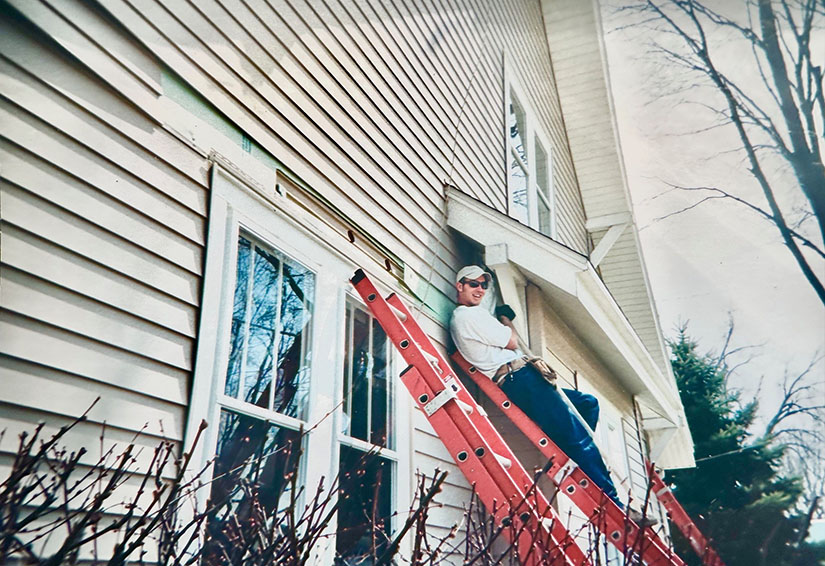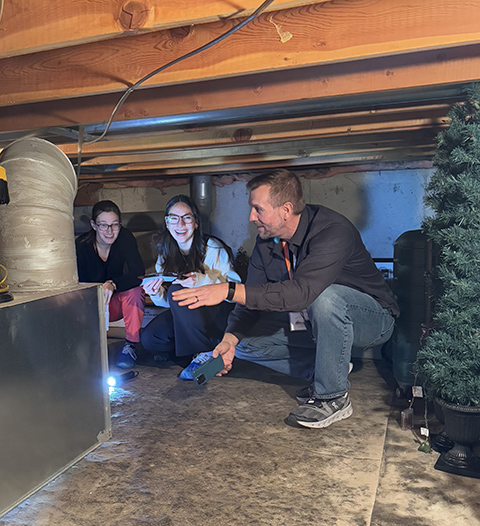A Career Built on Helping Others: Cory Chovanec's Journey in Weatherization
NREL Researcher Uses His Field Experience To Help Increase Energy Affordability for Americans Through the Weatherization Assistance Program

At 17 years old, NREL researcher Cory Chovanec was traveling door to door in his hometown of Berlin, Wisconsin. His mission: to sell enough vacuum cleaners to qualify for an all-expenses-paid trip to Lake Tahoe. At around $1,000 dollars a pop and in a town of just over 5,000 people, it was no easy feat.
Yet he managed to sell them all—sending both him and his sister on a free vacation.
“I think if you can sell Kirby vacuums at that price in the '90s, you can do just about anything,” Chovanec said.
After following a career path in the weatherization and home performance industry from entry level to a position at a national laboratory, Chovanec found that he really could do just about anything—from crawling through cold, uninsulated subspaces and hot attics to inspecting hundreds of homes with advanced diagnostic equipment.
Now serving as weatherization team lead at NREL, Chovanec has worked in many different roles supporting the U.S. Department of Energy (DOE) Weatherization Assistance Program (WAP). The program aims to reduce energy costs for low-income households by increasing home energy efficiency. Weatherization saves money for families and enhances health, home comfort, and safety.
In his nearly four years at NREL, Chovanec has contributed to and led technical assistance, research, and resource development to support WAP, leveraging his extensive experience to ensure these activities benefit field staff and aid in their work improving energy affordability across the country.
Bit by the Weatherization Bug
Chovanec did not even know what weatherization was until after high school, when he started working for a local temporary employment agency. One day, they placed him at a community action agency, where he filled in as a weatherization technician.

“I didn’t see this as a career. I thought these people were crazy, crawling around attics and everything,” Chovanec said.
Chovanec was in a Wisconsin farmhouse in the middle of winter when he began to feel the impact of the work “click” for him. It was his first time insulating an attic on his own, and the space was almost unbearably hot because of the lack of insulation. This meant that a large amount of heat was escaping out from the living space, ultimately costing the kind, elderly owners more money to warm their home. As he carried out his work, blowing 13 to 14 inches of insulation over the attic floor, he noticed the attic change from hot to cold. With less heat escaping into the attic, the owners would need less energy to warm their home—greatly reducing their energy bills.
Chovanec was hooked. “It was then I could actually feel that this work really does make a difference,” he said.
Workers in the industry describe this feeling as “getting bit by the weatherization bug.” The work is physically taxing, but Chovanec feels the reward goes far beyond a paycheck. Weatherization technicians and energy auditors are regularly exposed to the extreme heat and cold, exploring all the unseen and potentially hazardous places in a home. Yet Chovanec believed strongly in the WAP mission, saving money on energy bills, and helping people be comfortable and safe in their homes.
Without prior knowledge of building science or weatherization work, Chovanec learned on the job. Absorbing skills and knowledge through every task and mentorship experience, he accepted a full-time role and climbed the career ladder at the community action agency, eventually accepting a position at a weatherization training center.
Weatherization training centers provide structured hands-on training opportunities to workers in the weatherization and home performance industry. Chovanec’s main roles at the center were to provide building science training and perform quality control inspections for the state. These inspections help ensure the appropriateness and quality of the work completed on the home by installers and technicians. Chovanec estimates he visited all 72 counties of Wisconsin at least once to perform inspections during his 10-plus years at the center.
“One of the best things was going back to do a post-weatherization inspection and hearing nothing but good things,” Chovanec said. “Their bills are going down, their house is more comfortable, they physically feel better—it’s just a dose of good news.”
For Chovanec, home energy auditing is a passion, not just a job. An energy audit consists of a thorough examination to identify potential comfort or safety problems and energy-saving opportunities. He works on his field skills in his free time, taking the four-hour energy auditor recertification field exam every three years. He has now passed the exam five times and enjoys providing home assessments for his friends and family.
While an energy audit might provide homeowners with the most comprehensive look at ways to cut energy costs in their home, Chovanec emphasized that there are simple steps people can take to minimize energy use and lower bills. Even just ensuring that lights are off in empty rooms and the thermostat is adjusted when you are out of the house can make a difference.
“When you were a kid and your parents told you to turn the light off when you’re not in the room: That is real, and it helps,” Chovanec said. “We all have control over small things like that, and if we want to save some money on a utility bill, we can achieve that without extensive training.”
Translating Field Experience Into Valuable Workforce Resources
In keeping with his unique ability to simplify complex concepts, Chovanec's favorite projects examine the most technical aspects of weatherization work to streamline them or make them easier to understand.
One of these projects includes the development of two interactive 3D houses, providing virtual examples of a single-family and manufactured home. These learning tools allow users to explore relevant retrofit strategies and common weatherization measures for different areas of the home, all with a few clicks of their mouse. Chovanec used his field experience to accurately represent the spaces.
“When thinking about developing resources for the weatherization network, you have to think about how it will look in the hands of the people actually doing the work,” Chovanec said.

Chovanec also assists volunteer expert committees with updating job task analyses for energy auditor and quality control inspector certification schemes, the role that introduced him to NREL when he volunteered to serve on the update committee as a subject matter expert. These resources are updated roughly every five years with weatherization industry feedback.
“We are really working to improve the foundational components of credentials through each update cycle, and this is clear with each iteration,” Chovanec said. “The program is always evolving in a way that puts an emphasis on high-quality work that saves people money.”
Over the years, Chovanec has seen WAP grow in a variety of ways, providing more robust, formalized education and incorporating new technologies as they emerge, like infrared imaging, which helps identify air leaks and thermal anomalies in homes. As research continues, Chovanec knows that there will always be something new to improve homes and lives, and he is excited that NREL can play a key part in those discoveries and enhancements.
When reflecting on his career journey—from his first WAP agency to NREL—Chovanec said it is important to reach out and take hold of opportunities as they come.
“The stepping stones are there, you just have to follow the path: volunteer for those committees, go to extra trainings, try to make the most of it,” Chovanec said. “No matter what my role was, I just felt really fortunate to work in WAP and have been mentored by so many incredible and brilliant people, some of whom were around when the program first began in 1976. It is a privilege to continue to support this program.”
Last Updated May 28, 2025
